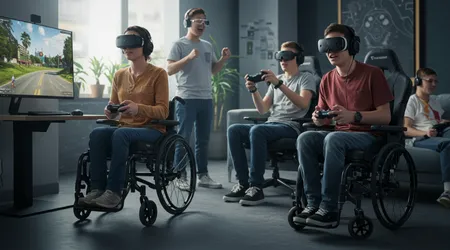Inclusive Gaming: How Developers Are Building for Everyone

Inclusive gaming is reshaping the video game industry, ensuring everyone, regardless of ability, can enjoy immersive digital worlds.
In 2025, developers are prioritizing accessibility, driven by both ethical imperatives and market potential.
With over 3 billion gamers globally, including an estimated 400 million with disabilities, the push for universal design is no longer optional it’s transformative.
This blog post explores how innovative technologies, thoughtful design, and community collaboration are making games accessible to all, while highlighting real-world examples and current trends.
Why should gaming exclude anyone when it can unite us all?
The gaming landscape has evolved dramatically, with inclusive gaming at its core. Accessibility isn’t just about compliance; it’s about creativity and empathy in design.
From AI-driven interfaces to adaptive hardware, developers are crafting experiences that break barriers.
This article dives into the strategies, technologies, and cultural shifts driving this movement, offering insights into how the industry is building for everyone.
The Rise of Accessibility in Game Design
Thoughtful game design is the foundation of inclusive gaming. Developers now integrate accessibility from a project’s inception, not as an afterthought.
Features like customizable controls, subtitle options, and colorblind modes are standard in many AAA titles. For instance, The Last of Us Part II (2020) set a benchmark with over 60 accessibility options, inspiring 2025’s new releases.
Naughty Dog’s approach shows how empathy drives innovation. Their game allows players to adjust haptic feedback for motor impairments, proving accessibility enhances gameplay for all.
Recent titles like Horizon Forbidden West continue this trend, offering one-button combat modes for cognitive ease. These features demonstrate that inclusive gaming prioritizes player choice.
Moreover, indie studios are making waves. A Short Hike (2019) offers simplified controls for younger or disabled players, showing small teams can prioritize accessibility.
++ Why Mainstream Tech Needs Built-In Accessibility from Day One
In 2025, tools like Unity’s accessibility plugins help developers embed inclusive features early, streamlining the process. This democratization of tools fuels a broader movement.
The cultural shift is palpable. Developers now consult with disability advocates during design phases, ensuring authenticity.
This collaboration fosters trust and ensures features meet real needs, not assumptions. Inclusive gaming thrives when voices from diverse communities shape the creative process.

Adaptive Hardware: Opening New Doors
Hardware innovation is revolutionizing inclusive gaming. Devices like the Xbox Adaptive Controller (2018) remain a gold standard, allowing players to customize inputs via switches and joysticks.
In 2025, Sony’s Project Leonardo for PS5 expands this legacy with modular controllers tailored for motor disabilities.
Consider Emma, a gamer with cerebral palsy. Using the Xbox Adaptive Controller, she plays Elden Ring with foot pedals, a setup unimaginable a decade ago.
Also read: Exoskeletons and Mobility: Where We Are in 2025
Such hardware empowers players to engage with complex games, proving inclusive gaming isn’t about simplifying experiences but enabling access.
Emerging tech like eye-tracking devices, such as Tobii Dynavox, further transforms gaming. Players with severe motor impairments control games like Cyberpunk 2077 using gaze-based inputs.
These advancements show how hardware bridges gaps in traditional gamepad design.
At CES 2025, startups showcased brain-computer interfaces (BCIs) for gaming, allowing thought-based inputs.
While still experimental, BCIs hint at a future where physical barriers vanish. Inclusive gaming thrives when hardware evolves alongside software, creating seamless experiences.
The market reflects this demand. According to a 2024 AbleGamers report, the disability gaming market represents $13 billion annually, incentivizing companies to innovate. Hardware accessibility isn’t charity it’s smart business that enriches the gaming ecosystem.
AI and Machine Learning: Personalizing Play
Artificial intelligence is a game-changer for inclusive gaming. AI-driven features adapt games in real-time, tailoring experiences to individual needs.
For example, Call of Duty: Black Ops 6 (2024) uses AI to adjust difficulty based on player performance, aiding those with cognitive challenges.
Machine learning also enhances accessibility through voice controls.
Players with motor impairments navigate menus in Assassin’s Creed Mirage using natural language, reducing reliance on complex inputs. This tech makes inclusive gaming intuitive and dynamic.
AI-powered subtitles go beyond text. In Starfield (2023), real-time audio description narrates environmental details for visually impaired players, creating immersive experiences.
Read more: How AI-Powered Translators Help the Deaf Community
These advancements show AI’s potential to make games universally accessible.
Imagine gaming as a universal language, where AI translates barriers into opportunities.
In 2025, AI chatbots assist neurodivergent players by simplifying in-game instructions, as seen in Fable. This personalization ensures no one is left behind.
However, challenges remain. AI must avoid biases, and data privacy is critical. Developers are addressing these concerns through ethical design, ensuring inclusive gaming remains trustworthy and equitable.
Policy and Advocacy: Driving Change
Policy changes are accelerating inclusive gaming. The U.S. Department of Justice’s 2024 mandate requires digital learning resources, including games, to meet WCAG 2.1 standards by 2026.
This pushes developers to prioritize accessibility in educational titles.
Advocacy groups like AbleGamers lead the charge. Their Player Panels connect developers with disabled gamers, ensuring authentic feedback. Titles like Marvel’s Spider-Man 2 benefited from such collaborations, offering robust sensory options.
Globally, the 2022 WHO-UNICEF Global Report on Assistive Technology highlights inequities, noting only 10% of those needing assistive products have access. This underscores the need for affordable gaming solutions in low-income regions.
In 2025, conferences like the Access-Ability Summer Showcase highlight accessibility-first games, amplifying indie developers’ efforts. These platforms foster dialogue and inspire industry-wide change.
Legislation and advocacy aren’t just bureaucratic they’re catalysts for innovation. By aligning policy with community needs, inclusive gaming becomes a cultural norm, not an exception.
Community Collaboration: The Heart of Inclusion
The gaming community is the heartbeat of inclusive gaming. Disabled gamers share feedback on platforms like CanIPlayThat.com, guiding developers toward meaningful improvements. This dialogue shapes titles like God of War Ragnarök.
Streamers with disabilities, like RockyNoHands, showcase adaptive tech on Twitch, inspiring others to game. Their visibility normalizes accessibility discussions, pushing developers to act.
Modding communities also contribute. Fans create accessibility mods for older games, like Skyrim, adding subtitles or simplified controls. These grassroots efforts highlight the power of collective innovation.
In 2025, hackathons focused on accessible game design, like those hosted by Global Disability Innovation Hub, unite coders and advocates. These events produce prototypes that influence mainstream titles.
Collaboration isn’t just practical it’s emotional. When players feel heard, gaming becomes a shared journey, reinforcing the ethos of inclusive gaming as a movement for all.
Table: Key Accessibility Features in 2025 Games
| Game Title | Accessibility Feature | Disability Addressed |
|---|---|---|
| The Last of Us Part II | Customizable haptic feedback | Motor impairments |
| Horizon Forbidden West | One-button combat mode | Cognitive impairments |
| Call of Duty: Black Ops 6 | AI-adjusted difficulty | Cognitive impairments |
| Starfield | Real-time audio description | Visual impairments |
The Business Case for Inclusion
Investing in inclusive gaming is profitable. A 2020 Accenture report found companies prioritizing digital inclusion see 28% higher revenue. For gaming, accessibility expands markets by 15-20%, reaching millions of untapped players.
Consider Ratchet & Clank: Rift Apart (2021), lauded for its accessibility features. Its commercial success proves inclusive design doesn’t compromise quality it enhances it.
Indie games like Celeste show accessibility can be a selling point. Its assist mode for motor-impaired players boosted its appeal, earning critical acclaim.
In 2025, companies like EA integrate accessibility teams early, reducing retrofitting costs. This proactive approach maximizes ROI while fostering brand loyalty.
The analogy is clear: accessibility is like building a ramp instead of stairs it benefits everyone. Inclusive gaming isn’t just ethical; it’s a strategic advantage.
Frequently Asked Questions
What is inclusive gaming?
It’s designing games to be accessible to all, regardless of physical or cognitive abilities, using adaptive tech and universal design principles.
How do adaptive controllers work?
Devices like the Xbox Adaptive Controller allow customizable inputs, such as switches or pedals, enabling players with motor impairments to game comfortably.
Why is accessibility important in gaming?
With 400 million disabled gamers globally, accessibility ensures everyone can enjoy gaming, boosting inclusion and expanding market reach.
What role does AI play in inclusive gaming?
AI personalizes experiences through voice controls, dynamic difficulty, and audio descriptions, making games accessible to diverse players.
